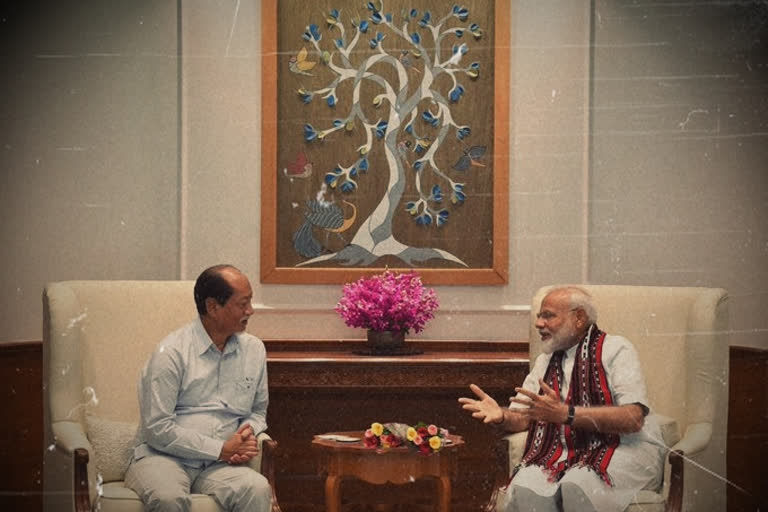Hyderabad: The perplexing inflexibility on extending the deadline from October 31 may result in undermining the efforts of 22 years of protracted negotiations between the Government of India and the Thuingaleng Muivah-led Naga underground leadership of the National Socialist Council of Nagalim (NSCN-IM).
The talks to find a lasting solution to the seven-decade-old insurgency problem in Nagaland continued for the third consecutive day on Wednesday, with the Centre's interlocutor and Governor R N Ravi holding two rounds of discussions with the NSCN-IM, officials said.
While the dialogue with the Naga National Political Groups (NNPG) is almost over, the talks with the NSCN-IM, a major insurgent group in the Northeast, has been continuing as the outfit continues to insist on its demands for a separate flag and Constitution for the Nagas.
At a time when a European Union delegation is visiting Kashmir, it will be diplomatic hara-kiri to grant a separate Naga flag and a constitution to the Nagas, when the same have been abrogated in Jammu and Kashmir.
There is an imminent danger of history repeating itself. Like the Shillong Accord of 1975 that gave birth to a new underground faction of Nagas—the NSCN—who opposed the accord thereby starting a new violent chapter in the Naga insurgency movement.
Implicit in the October 31 deadline is the strong possibility of the government signing an accord without Muivah but with the Naga National Political Groups (NNPGs) and a clutch of senior NSCN (IM) leaders who have broken ranks with Muivah to join the NNPGs.
NNPG is a platform of several Naga groups including former insurgents and breakaway factions of the NSCN that have expressed willingness to sign an accord with the government even without being granted a separate constitution and a Naga national flag, something that Muivah and his staunch followers are not willing to concede.
The NNPGs’ willingness is understood to be a reflection of many Nagas who seek an end to the vexed Naga issue and move on after accepting the practical reality that an armed movement is not possible against the might of the Indian state.
In effect, an agreement may be signed without the co-guarantor and the signature of the man with whom the negotiations started and who is now, arguably, the main face of the Naga insurgency movement.
But what is also glaring here is the rigidity and inflexibility shown by both the sides—a strict no-no in negotiations. It has threatened to put all the progress achieved in the last 22 years of negotiations to smoke.
The framework agreement was signed on August 3, 2015 by NSCN-IM leader Thuingaleng Muivah and Ravi in the presence of Prime Minister Narendra Modi.
The framework agreement came after over 80 rounds of negotiations spanning 18 years, with the first breakthrough in 1997 when the ceasefire agreement was sealed after decades of insurgency in Nagaland which started soon after India's Independence in 1947.
The stirrings for independence among the Nagas first started in around 1917 when the British took thousands of young able-bodied Nagas to aid the WW I war effort in France where they were put to building houses, barracks, other construction activity besides digging trenches.
Equipped with a limited world view and of their surroundings till then, it was the first exposure of Nagas to the outside world. Left to their own, there was a growing realisation of the underlying commonalities among the various Naga tribes from present-day Nagaland, Arunachal Pradesh and Assam.
With a new-found sense of unity, these men came back home from the foreign shores and set up the Naga Club in 1918. In 1929, the Naga Club submitted a memorandum to the Simon Commission seeking the right to self-determination as and when the British left India.
It was left to an Angami Naga, ZA Phizo, to give new direction and force to the movement with complete sovereignty and independence as its prime aim. Easy availability of weapons left behind by the retreating Japanese forces and active help from China added further fillip to Phizo's movement.
While the NSCN (IM) has now watered down the demand for independence to ‘shared sovereignty’ where Nagaland will be allotted much more powers and autonomy than that allotted to other Indian states, clearly the fate of the talks hangs in balance.
At the moment, unconfirmed reports are coming in of hundreds of NSCN (IM) fighters sneaking out with their weapons from their designated camps in Nagaland to their hideouts in neighbouring Myanmar and from there a possible movement towards China. Clearly, China would be accorded a major advantage.
With the peace process left hanging, there will be a growing threat of more fratricidal conflicts. An unresolved Naga issue would only result in more insurgency and counter-insurgency operations which serves no one’s purpose—neither the Government’s nor that of the Nagas.
A pact with the Nagas minus the NSCN (IM) and Muivah is rather meaningless as it is the mainstay of the Naga insurgency at this point of time. The other powerful faction started by the late SS Khaplang called the NSCN (K) is already outside the pale of the ongoing negotiations and continues to operate its training camps inside Myanmar. Although a remote possibility now, NSCN (IM) and NSCN (K) joining hands will be a security nightmare.
Already, most insurgent groups from India’s Northeast are organised under a single platform called the United National Liberation Front of Western South East Asia (UNLFWSEA). Formed in 2015, UNLFWSEA, owning the allegiance of thousands of armed fighters, operate from an ungoverned and inaccessible swath of territory about 60,000 sq km in size and roughly 50 km in width. This lawless zone stretches about 1,300 km in length from Arunachal Pradesh in the north to Manipur in the south.
In such a situation, extending the October 31 deadline may the work of the wise.



